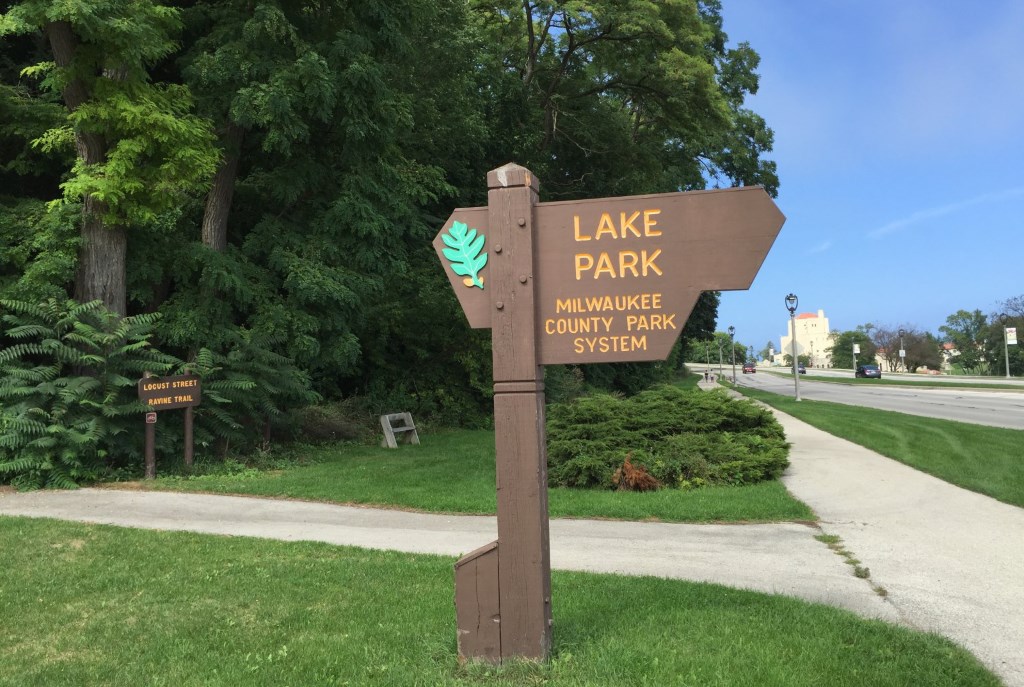Will County Ever Be Able to Afford Parks System?
New Wisconsin Policy Forum report looks at potential tools and agreements to pay for park maintenance.

Lake Park sign. Photo by Dave Reid.
Milwaukee County Parks has a list of maintenance needs that appear insurmountable. If the county is ever going to address them all, it will need to get creative.
That, at least, is the logic behind a new report by the Wisconsin Policy Forum (WPF) called “Natural Partners” that looks at unique intergovernmental agreements and financial tools as a way to begin chipping away at infrastructure maintenance in county parks.
The study was conducted in partnership with Milwaukee County Parks. It focuses, in particular, on two broad ways the county can find help maintaining the parks system. The first is to work with the Milwaukee Metropolitan Sewerage District (MMSD) on mutual interests around stormwater management and local waterways. The second is exploring intergovernmental agreements, and leases, with municipalities in the county.
In both cases, there is already some precedent for Parks tapping these funding sources for maintenance. However, examples, so far, are limited and haven’t occurred at a level needed to address the scope of maintenance needs in the parks system. The 15,000-acre system includes 142 parks, 65 miles of parkways, 142 acres of parking lots and 184 miles of trails.
The Backlog
The problem facing the parks department is not a new one.
WPF estimates that the backlog is approximately $496 million worth of infrastructure needs — not including the cost to repair or replace the Mitchell Park Domes. Just to address the backlog — not to build anything new or make improvements — Parks would need to spend approximately $20 million a year for the next 25 years on these infrastructure needs. That level of spending is not occurring and hasn’t for some time.
Financially, Milwaukee County Parks is extremely limited. The property tax levy dedicated to the parks system has shrunk for decades. Between 1989 and 2019, the share of the county’s total property tax levy shrunk from 23% to 5%. The amount of funding set aside for infrastructure projects has been similarly reduced.
This reflects county governments’ broader financial struggle over the past few decades. Years of budget cuts led to a Parks budget in 2018 that only included $2.7 million for infrastructure maintenance, a far cry from the $20 million needed annually to address the backlog.
Partnership with Sewerage District
Parks and the MMSD have many overlapping interests, both geographically and in mission.
MMSD is, in fact, a local government. It is the government that, quite literally, operates underneath the surface. But it has a specific brief: water treatment and flood management for approximately 28 communities in the greater Milwaukee area, representing more than 1 million residents.
One of the MMSD’s chief concerns is managing stormwater runoff and preventing the flow of untreated stormwater into Lake Michigan. The district maintains jurisdiction over many tributary streams and creeks in the region. These waterways run through 40 parks in the system. Both Parks and MMSD are interested in environmental stewardship and reducing stormwater runoff, and which opens up opportunities for partnerships, the report found.
An expanded partnership between the two entities could be mutually beneficial, according to the report. MMSD is constantly seeking to reduce stormwater runoff and flooding. And Parks has a lot of land that could be useful for this. MMSD can use the land for its stormwater management infrastructure and Parks can tap into this funding for nearby improvements or maintenance.
Projects in Jackson Park and Pulaski Park, where MMSD removed the concrete lining from the Kinnickinnic River and also financed some nearby park improvements are held up as examples in the report.
Municipal Funding?
The WPF report also looked at expanding Parks’ existing approach to intergovernmental agreements and leases for parkland with local municipalities.
Local municipalities have an interest in making sure their local county parks are well maintained. And this interest has led some municipalities — Oak Creek and Greenfield — to approach Parks about maintenance agreements for some parks and assets. In the past these agreements have been limited in scope, sometimes to a single ball field. Many more agreements, would be needed to have a meaningful impact on the backlog. Or Parks could reconsider its role.
The department could focus solely on the 31 larger, regional parks. Maintenance of smaller, neighborhood parks would become the purview of municipalities.
In the city of Milwaukee, Parks has partnered with the city recently on improvements in county parks using funding from the city’s tax-incremental financing (TIF) districts . The county, under state law, does not have access to tax incremental financing, which can use increased property tax collections from development to fund public improvements within a half-mile of their boundaries.
WPF notes that the city of Milwaukee has its own financial trouble, and that increased use of TIF will add to the city’s debt load. However, the unique nature of TIF revenue presents an opportunity for financial support from the city that is in less conflict with other areas of its budget.
Political Buy-In Needed
Expanding municipal maintenance agreements or tapping into MMSD funding will require greater political buy-in from elected officials at multiple levels of government.
Maintenance agreements, like one for Kulwicki Park in Greenfield, have faced stiff resistance from members of the County Board of Supervisors, the report notes. And the negotiations over these deals, and ones with MMSD, tend to be protracted, reducing the appetite on either side for more.
State legislators also introduced legislation at the state level seeking to pre-empt any expanded cooperation between Parks and MMSD beyond improvements to stormwater infrastructure. The bill was never adopted, but MMSD and Parks employees interviewed for the report noted that it had a chilling effect on expanding the relationship between the two entities.
In any case, the parks system has more maintenance than it can afford. And WPF believes that proactively working on creative solutions could help the system’s case as it seeks more local or state funding.
Read the full Wisconsin Policy Forum report.
If you think stories like this are important, become a member of Urban Milwaukee and help support real, independent journalism. Plus you get some cool added benefits.
MKE County
-
RNC Will Cause Some County Services To Be Moved to Wauwatosa
 Jul 12th, 2024 by Graham Kilmer
Jul 12th, 2024 by Graham Kilmer
-
Hank Aaron State Trail Will Be Closed For RNC, State Fair
 Jul 12th, 2024 by Graham Kilmer
Jul 12th, 2024 by Graham Kilmer
-
MCTS Designing New Bus Shelters
 Jul 10th, 2024 by Graham Kilmer
Jul 10th, 2024 by Graham Kilmer





















Some, hopefully, relevant thoughts on this important subject: First, parks are critical to healthy community life, and Milwaukee has been blessed with some of the best parks in the country.
Second, people can become accustomed to anything, especially, as Tolstoy once said, if they see everyone around them living in the same way. Milwaukee’s residents have gotten used to lack of maintenance and decline in their parks system, and, as a result, spend less time than in the past in their parks.
Third, the Milwaukee County Park Commission, despite solid, committed management, faces a chronic, structural mismatch between needs and resources. Tinkering won’t work. Big problems call for big solutions.
Fourth, if you aggregate the various approaches to financing park maintenance suggested in this article, and they all come to pass, you will still come up short in meeting the system’s short and long-term needs.
Finally, there is a model – a “win-win” model – for meeting current needs and restoring County’s parks to their previous glorious state. That model is the Conservancy, a public-private partnership of the County and supporters in the corporate, philanthropic and social sectors. The primary role of the conservancy is to raise large amounts of money, amounts that meet all of the short and long-term needs of the system. This model is NOT the privatization of the parks. The best example of the conservancy in action is New York City’s Central Park, which has gone from being a battered, empty wreck to the world’s pre-eminent urban park. The model works in ways that none of the alternatives do.
Agree with Frank A Schneiger, especially what he calls the Conservancy, a public-private partnership between Milwaukee County (M-Co) Parks and local business, social and philanthropic sources, especially for Mitchell and Whitnall Parks.
Five M-Co Parks host Senior Centers (Clinton Rose, Washington, Kelly, McGovern, Wilson) and four others have Community & Recreation Centers (King, Kosciuszko, Wilson Ice, and Milwaukee County Sports Complex). These all serve as “MKE Hubs” to serve as focal points for the community–including older adults, and may serve as hubs of community engagement enabling us to have fully engaged lives. (Thanks to Eugene Guszkowski and the Select Committee on Senior Centers of the M-Co Commission on Aging for developing this plan.)
Public/Private/Philanthropic partnerships are the key to the success of M-Co Parks and facilities!